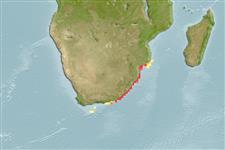>
Clupeiformes (Herrings) >
Engraulidae (Anchovies) > Engraulinae
Etymology: Stolephorus: Greek, stole, -es = garment + Greek, pherein = to carry (Ref. 45335).
More on author: Boulenger.
Environment: milieu / climate zone / depth range / distribution range
Ecologie
marien; brak water; oceanodroom (Ref. 51243); diepte 0 - 50 m (Ref. 189). Subtropical; 24°S - 40°S, 21°E - 37°E (Ref. 189)
Indian Ocean: Southwestern Indian Ocean, from northern Mozambique south to Port Elizabeth in South Africa (Ref. 189, 5430), including estuaries of Zwartkops River (Ref. 189, 5430), Kei River (Ref. 189) and Umtata River (Ref. 81587).
Grootte / Gewicht / Leeftijd
Maturity: Lm ? range ? - ? cm
Max length : 8.0 cm SL mannelijk / geslacht onbekend; (Ref. 189)
Dorsale stekels (totaal): 0; Dorsale zachte stralen (totaal): 15-17; Anale stekels 0; Anale zachte stralen: 20 - 23. Diagnosis: Body somewhat compressed, belly with 6-8 small needle-like pre-pelvic scutes, no post-pelvic scutes; maxilla tip pointed, reaching to or beyond hind border of pre-operculum, the latter concave, indented near maxilla tip; lower gillrakers 24-29; anal fin short, usually with 3 unbranched and 17-20 branched finrays, its origin below about middle of dorsal fin base (Ref. 189, 5430). Of similar species in its distribution area, Stolephorus indicus is round-bodied and has a shorter maxilla, not to hind border of pre-operculum; and Encrasicholina punctifer has the anal fin origin behind the dorsal fin base (Ref. 189).
A coastal, pelagic and schooling species; its presence in estuaries suggests that it can tolerate brackish water (Ref. 189). It is common along shore and in estuaries (Ref. 5430). It feeds on plankton, mainly copepods (Ref. 58304). It spawns in summer, usually at sea (Ref. 58304).
Levenscyclus en paargedrag
Maturiteit | Voortplanting | Paaien | Eieren | Fecunditeit | Larven
Whitehead, P.J.P., G.J. Nelson and T. Wongratana, 1988. FAO Species Catalogue. Vol. 7. Clupeoid fishes of the world (Suborder Clupeoidei). An annotated and illustrated catalogue of the herrings, sardines, pilchards, sprats, shads, anchovies and wolf-herrings. FAO Fish. Synop. 125(7/2):305-579. Rome: FAO. (Ref. 189)
Status op de Rode Lijst van het IUCN (Ref. 130435)
Gevaar voor de mens
Harmless
Gebruik door de mens
Meer informatie
Lokale namenSynoniemenMetabolismePredatorenEcotoxicologieVoortplantingMaturiteitPaaienPaaiaggregatiesFecunditeitEierenOntwikkeling van de eieren
ReferentiesAquacultuurAquacultuurprofielKweeklijnenGeneticaElectrophoresesErfelijkheidZiektesVerwerkingNutrientsMassaconversie
Tools
Speciale rapporten
Download XML
Internetbronnen
Estimates based on models
Preferred temperature (Ref.
123201): 21.2 - 24.9, mean 24.3 °C (based on 12 cells).
Fylogenetische diversiteitsindex (Ref.
82804): PD
50 = 0.5000 [Uniqueness, from 0.5 = low to 2.0 = high].
Bayesian length-weight: a=0.00759 (0.00432 - 0.01334), b=3.19 (3.04 - 3.34), in cm total length, based on LWR estimates for this species & (Sub)family-body (Ref.
93245).
Trofisch niveau (Ref.
69278): 3.3 ±0.4 se; based on size and trophs of closest relatives
Weerstandsvermogen (Ref.
120179): Hoog, minimale populatieverdubbelingstijd minder dan 15 maanden (Preliminary K or Fecundity.).
Fishing Vulnerability (Ref.
59153): Low vulnerability (10 of 100).
